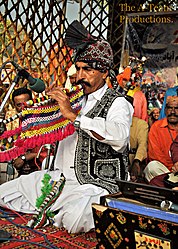Alghoza
Alghoza is a combination of musical wind instruments. The Baloch, Saraiki, Sindhi, Kutchi, Punjabi and Rajasthani folk music artists play these instruments.[2][1] It is also called Alghoza, Jōrhi, Pāwā Jōrhī, Do Nālī, Donāl, Girāw, Satārā or Nagōze.
 | |
| Woodwind | |
|---|---|
| Other names | Alghoze, Jōrhi, Pāwā Jōrhī, Do Nālī, Donāl, Girāw, Satārā or Nagōze[1] |
| Classification | Woodwind instrument |
| Hornbostel–Sachs classification | 421.112 |
| Developed | around 7500 BC in Mesopotamia[2] |
| Musicians | |
Origin
changeThis musical grouping first happened around 7500 BC in Mesopotamia. Then it reached Iran and eventually Pakistan. It had some changes on the way.[2] Some old Mesopotamian paintings show a musical instrument very similar to Alghoza.[2]
In Mesopotamia, this instrument was called "Al-Joza", which literally means, "the twin".[2] As it reached Pakistan, the "J" in "Al-Joza" became "gh" and eventually the modified form of this instrument which reached Pakistan came to be known as Alghoza.[2]
The Alghoza (Sindhi: الغوزو) is a paired woodwind instrument. It is traditionally used by Baloch, Saraiki, Sindhi, Kutchi, Punjabi and Rajasthani folk musicians. It consists of two joined beak flutes, one for melody, the second for drone. The flutes are either tied together or may be held together loosely with the hands.
References
change- ↑ 1.0 1.1 "Alghoza". Asian Music Circuit. Archived from the original on 27 February 2017. Retrieved 7 December 2015.
- ↑ 2.0 2.1 2.2 2.3 2.4 2.5 Chandio, Faraz (September 2, 2018). "CULTURE: THE DYING BREATHS OF THE ALGHOZA". DAWN. Islamabad. Retrieved June 3, 2021.
- ↑ Misri Khan Jamali on Pakistan Quarterly via GoogleBooks page 264. Pakistan Quarterly. 1967. Retrieved 9 June 2020.
- ↑ Shoaib Ahmed (12 December 2015). "Mystic Music Sufi Festival kicks off". Dawn (newspaper). Retrieved 10 June 2020.
- ↑ Yusuf, Zohra (1988). Rhythms of the lower Indus: perspectives on the music of Sindh. Dept. of Culture and Tourism, Govt. of Sindh.
- ↑ "An elegy to music". www.thenews.com.pk. Retrieved 2020-07-21.
- ↑ "TheNews Weekly Magazine". www.thenews.com.pk. Retrieved 2020-07-21.
- ↑ Kaur, Simmypreet (2011-10-01). "ਲੰਮੀ ਹੇਕ ਦੀ ਮਲਿਕਾ ਗੁਰਮੀਤ ਬਾਵਾ" [The queen of the long vocal note]. The Punjabi Tribune (in Punjabi). Retrieved 2013-10-17.
- ↑ Majari, Surjit (2010-12-25). "ਰਵਾਇਤੀ ਗਾਇਕੀ ਨੂੰ ਸੰਭਾਲਣ ਦੀ ਲੋੜ" [Need to preserve traditional music.]. The Punjabi Tribune (in Punjabi). Retrieved 2012-05-10.